On the evening of November 3, Chicago’s James R. Thompson Center reopened its doors to the public after being closed for close to a year in preparation for a sweeping—and character-stripping, some worry—corporate overhaul in which the Helmut Jahn-designed Postmodernist “People’s Palace” will emerge circa 2026, re-skinned and rejuvenated, as the Windy City headquarters of Google.
“We’re going to tear down the building to its structural height, and then redo it with material that’s energy-efficient,” explained Quintin E. Primo III, chairman and CEO of project co-developer Capri Investment Group, during a press tour held earlier that afternoon in the building, which was completed in 1985 as Illinois’ satellite state capitol and was put up for sale (again) by the state in 2019. “While the building is being taken private, this space that you’re in, the rotunda, will still be part of the public realm.”
Despite talk of demolishing the conical structure’s metal and glass exterior (and reassurances its atrium will remain public), the Thompson Center’s reopening that evening was literally cause for celebration—a kick-off party for This is a Rehearsal, the fifth edition of the Chicago Architecture Biennial (CAB 5). Curated by the four co-directors of art collective Floating Museum (architect Andrew Schachman, artists Faheem Majeed and Jeremiah Hulsebos-Spofford, and poet avery r. young), the fifth cycle of CAB recognizes “cities as sites of perpetual transformation,” said Hulsebos-Spofford, noting the team’s intention that the biennial function “not just as a flash-in-the-pan exhibition, but the beginning of long and enduring relationships” between municipal entities and community organizations with artists, architects, designers, and other creatives. “We’ve started dialogue that crosses power hierarchies and spaces, organizations and structures,” he added.
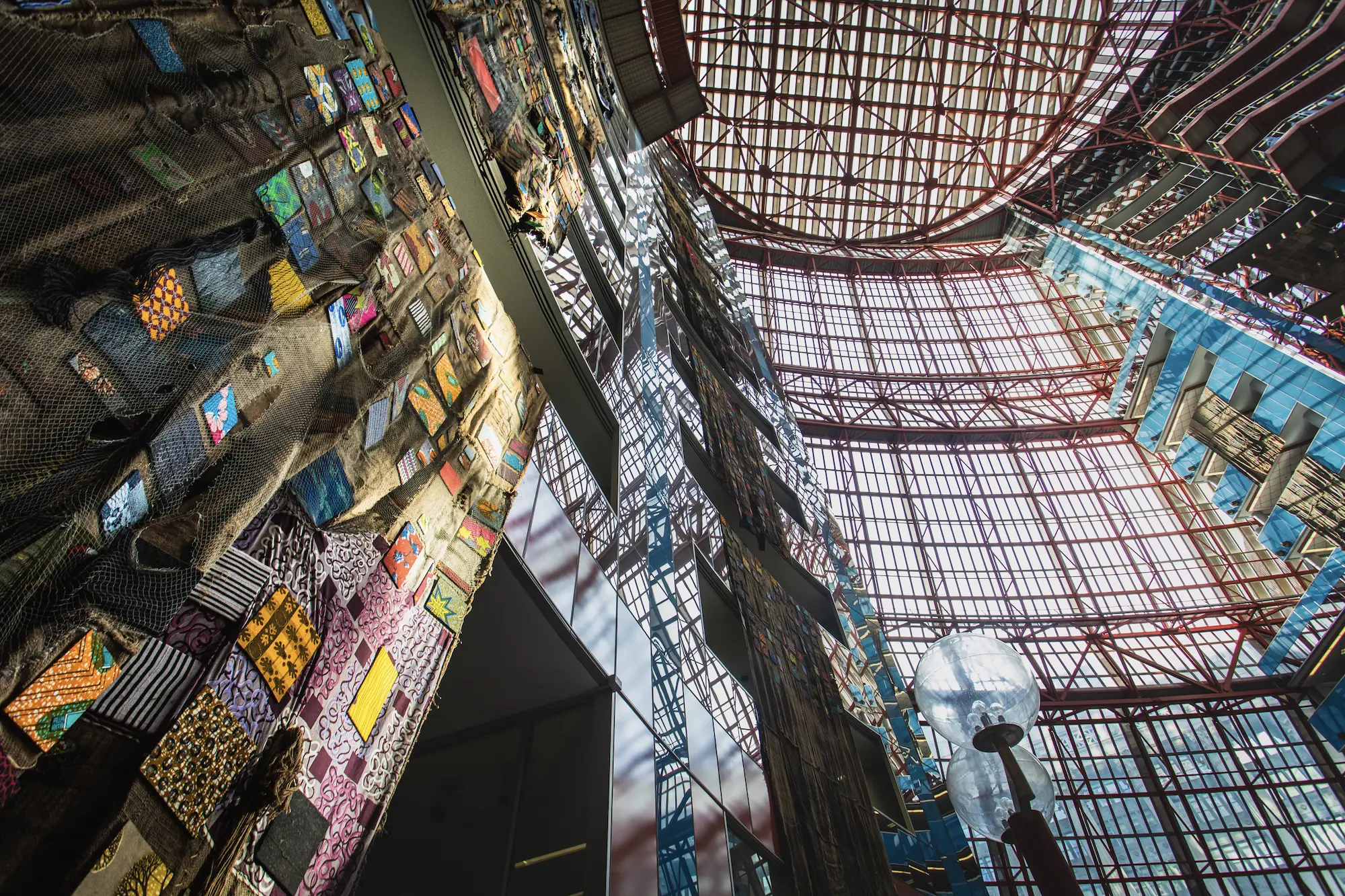
Large-scale textiles by Ibrahim Mahama in the Thompson Center atrium. Photo © Cory Dewald
During the party, a throng of attendees mingled in the Thompson Center’s skylit 17-story atrium, while smaller crowds decamped to the lower level’s vacated food court to partake in a silent disco. Spirits were high (with an assist from an open bar) as partygoers engaged with several site-specific installations. Among them: the swooping timber HygroShell Research Pavilion, conceived and fabricated by ITECH students at the University of Stuttgart; Ghanaian artist Ibrahim Maham’s series of banner-like tapestries stitched-together from found urban objects and draped over the kaleidoscopic atrium’s signature blue-and-salmon panels; and Forum, a hyper-futuristic metallic shell described by Chicago-based studio interference as a “stage, a screen, an instrument, and a backdrop, creating space that can be transformed through its use as a venue for convening, public programming, and the arts.” Just off the atrium, New York’s Storefront for Art and Architecture transformed a vacated Sprint store into a pop-up gallery space, while a cluster of tree stump seats, designed by Boston-based Stoss Landscape Urbanism, populated the building’s front plaza.
“When Floating Museum came to us with the idea of participating, it seemed like a no-brainer to leverage this moment in time,” said Joel Putman, chief design officer with Capri. “I think we’ve achieved something spectacular—it wasn’t just about putting a few pieces in but really activating the space.” At the end of the year (ahead of the biennial’s larger closing on February 11), the Thompson Center will be shuttered again to begin its $280 million metamorphosis.
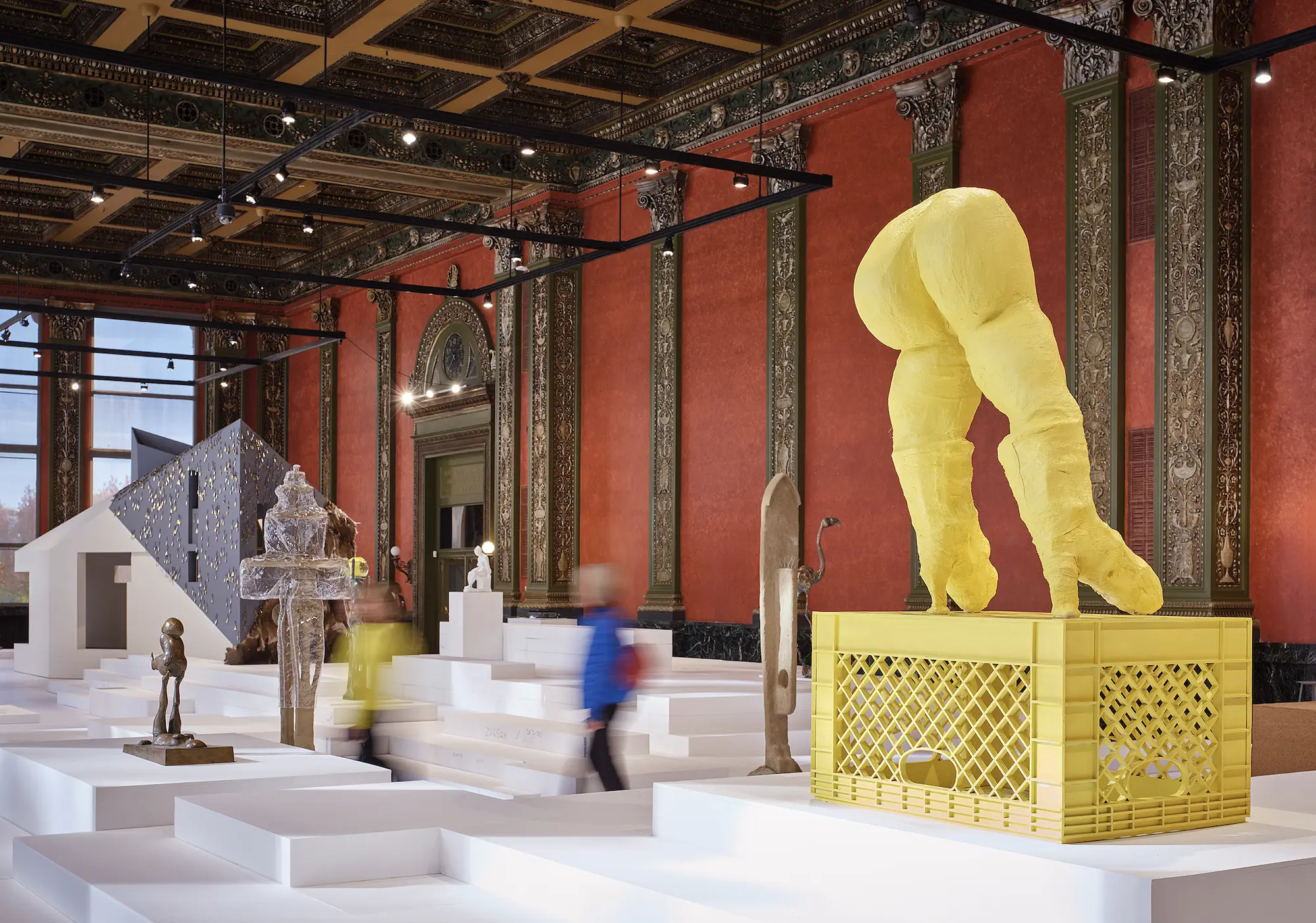
Works by contributors including Oren Pinhassi, Camille Hentrot, Tschabalala Self, Jean-Marie Appriou, Site Design Group, Elizabeth Catlett, and Chris T. Cornelius on view at the Yates Gallery at the Chicago Cultural Center. Photo © Tom Harris
One of CAB 5’s four anchor exhibition venues (along with the Chicago Architecture Center, the Graham Foundation, and the Chicago Cultural Center in its returning role as biennial hub), the Thompson Center’s additional role as backdrop for an opening weekend fête doubled as both a “hello again” and a final farewell to the building in its current form. At 14 participating “city sites” throughout Chicago, the biennial’s thematic “rehearsal” underpinnings were more apparent with the works on view—if on view at all—including prototypes, previews, trials, tryouts, and a taste of what’s to come.
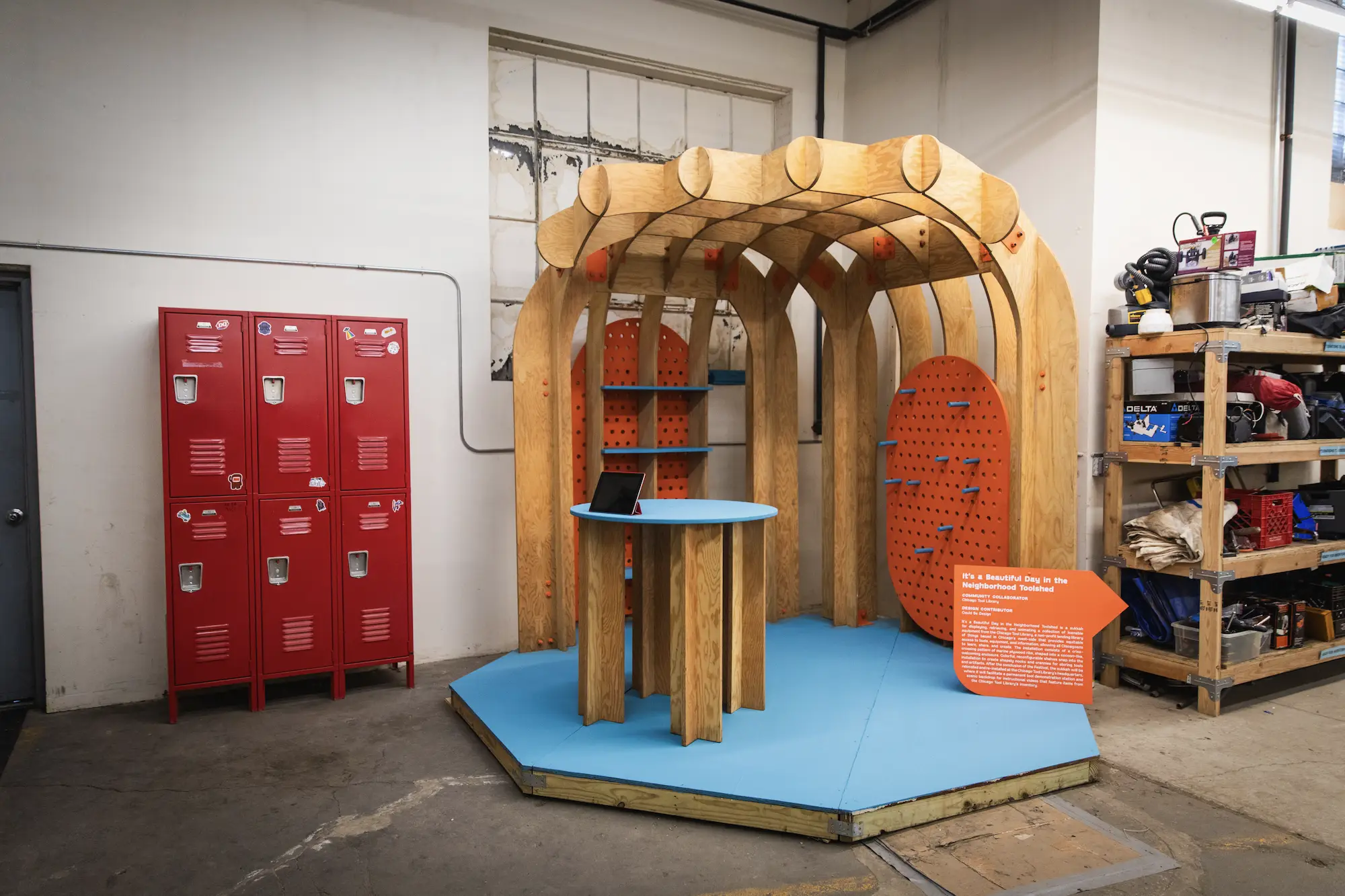
1
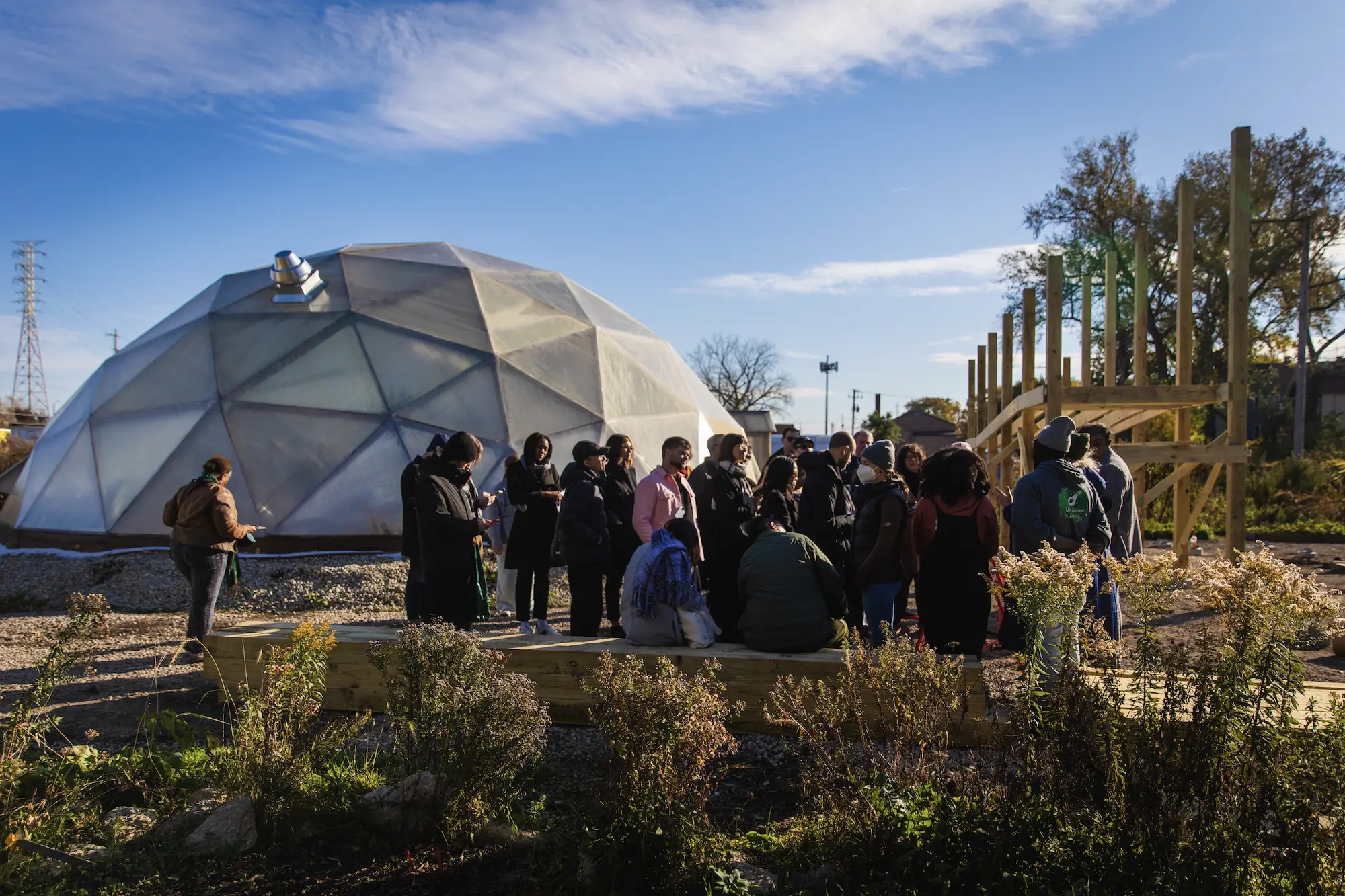
2
It's a Beautiful Day in the Neighborhood Toolshed by Could be Design at the Chicago Tool Library (1); a geodesic greenhouse at the Urban Growers Collective in South Chicago. Photos © Cory Dewald
At the non-profit Chicago Tool Library in the West Garfield Park neighborhood, a sukkah by Could Be Design, cleverly named It’s a Beautiful Day in the Neighborhood Toolshed, is being revamped into a “tool demonstration station.” At a vacant lot in Bronzeville, Norman Teague Design Studios teamed with artist Dorian Sylvian on Tetisi = Listen, a domed plywood pavilion paying homage to the abolitionist activism of Anna and Frederick Douglass that acts as a 1:1 scale model of a permanent monument to be eventually realized in copper at a public park in North Lawndale. And beneath an office tower in the Fulton Market District, three-time biennial partner SOM returns with Bio-Block Spiral, an installation realized in collaboration with Prometheus Materials that explores the carbon-neutral potential of algae-based bio-concrete bricks.
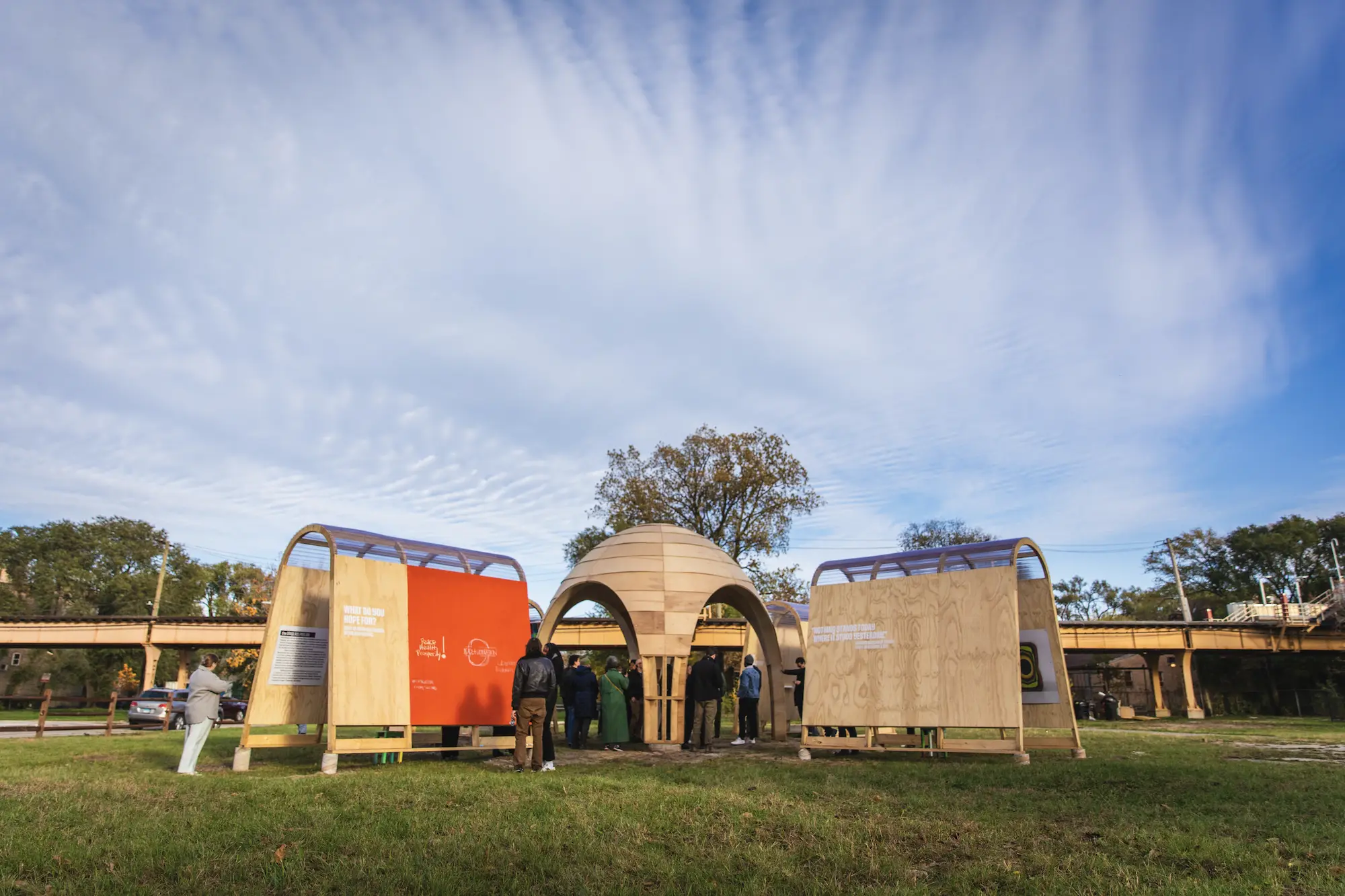
A temporary pavilion by Norman Teague Design Studios in Bronzeville. Photo © Cory Dewald
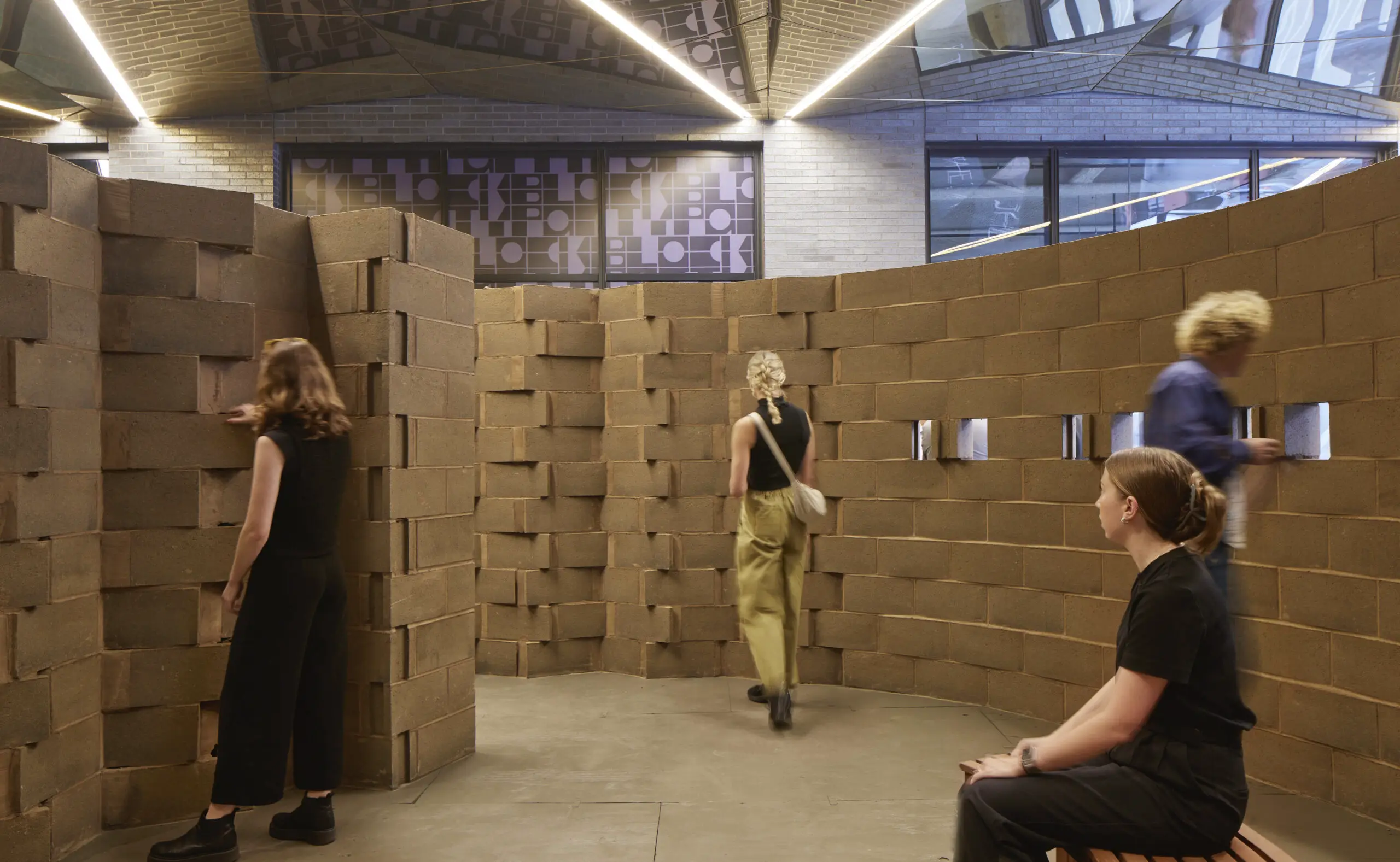
Bio-Block Spiral by SOM with Prometheus Materials. Photo © SOM/Dave Burk
The involvement of these sites is a key component of This is a Rehearsal, which positions Chicago as a sprawling stage for exploring the “endless possibilities that architecture holds in shaping our cities,” said Majeed. Featuring 86 participants hailing from 10 countries, the biennial is a hybrid of the first three cycles—all staged at the Chicago Cultural Center—and David Brown’s 2021 iteration that breathed new life into vacant lots scattered across the West and South Sides. What sets CAB 5 apart, said Majeed, is its “horizontal approach that stretches beyond the boundaries of traditional exhibition formats.”
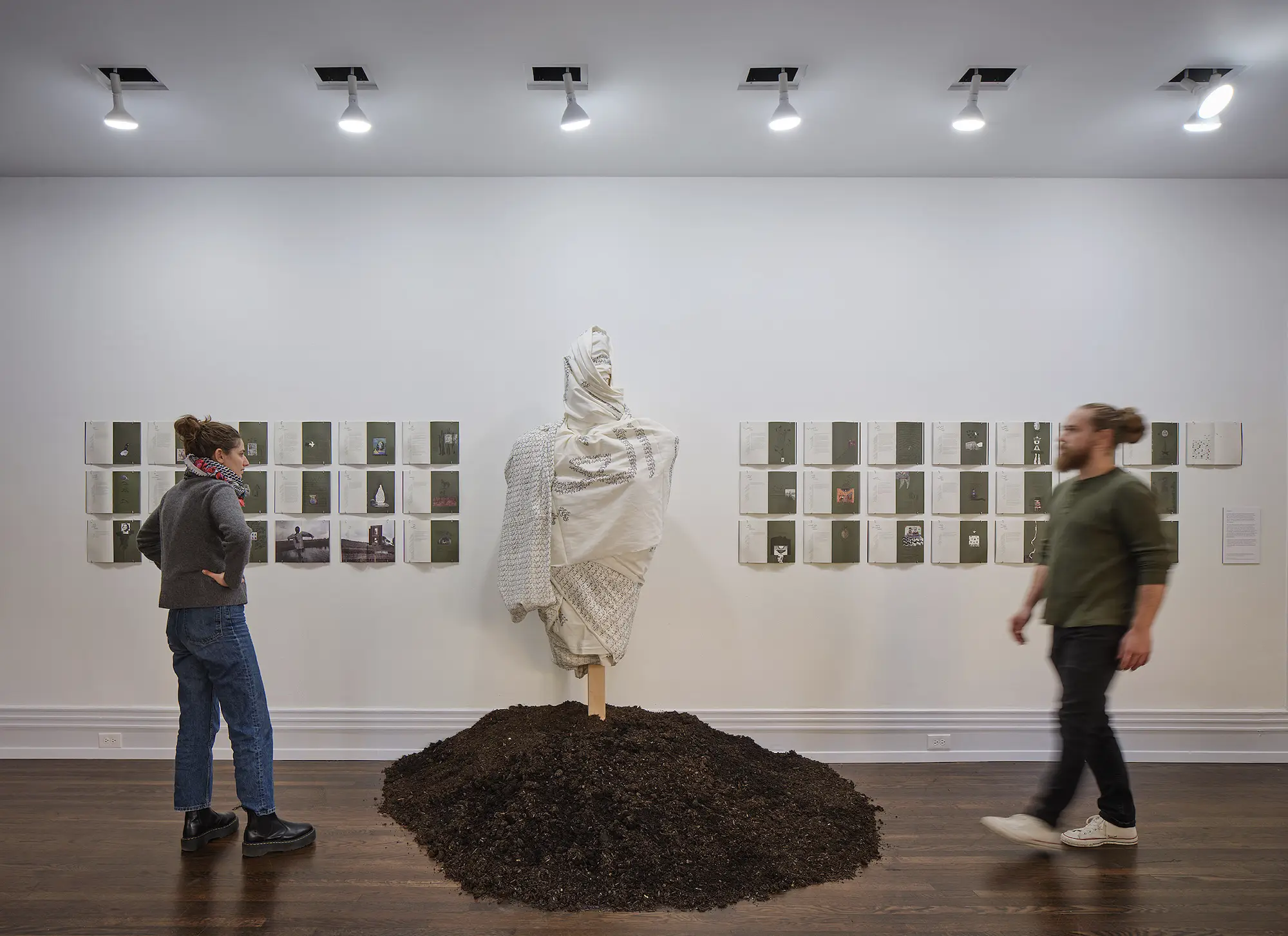
birdsong by Sigil Collective. The work is one of several pieces on view at the Graham Foundation as part of CAB 5. Photo © Tom harris
.jpg)
Systems, an exhibition featuring the work of Paris-based design studio ChartierDalix, on view at the Chicago Architecture Center as part of CAB 5. Photo © Anna Munzesheimer
This is a Rehearsal’s ambitious scale and emphasis on civic collaboration doesn’t go unnoticed. (Floating Museum and biennial organizers, led by CAB director Rachel Kaplan, pulled off something of a small miracle here.) The geographically sprawling exhibition, however, feels at times curatorially hazy; the inherent improvisation and experimentation that come along with the lead-up to the “big show” can be unwieldy.
Despite its aim to break out of the traditional exhibition format, CAB 5 is, perhaps strongest when it is at its most contained.
-6.39.02-PM.webp)
Cardboard Merzbau by Barkow Leibinger at the Chicago Cultural Center. Photo © Tom Harris
-6.39.02-PM.webp)
100 Chainsby the Buell Center and AD-WO at the Chicago Cultural Center. Photo © Tom Harris
The Chicago Cultural Center—a magnificent Neoclassical edifice erected in 1897 as Chicago’s central library—serves as backdrop to some of This is a Rehearsal’s most memorable commissions, including Berlin-based Barkow Leibinger’s Cardboard Merzbau, an entrancing tangle of tubes that engulf the building’s North Entrance lobby; set designer Ruth de Jong’s Haywood House, a full-scale, all-white foam-core replica of the alien-besieged farmhouse in Jordan Peele’s sci-fi thriller Nope; a functional sauna by Kiel Moe; and a decorative “fantasy coffin” by Ghanaian artist Paa Joe modeled after Mies van der Rohe’s Crown Hall at the Illinois Institute of Technology. With 100 Links: Architecture and Land, in and out of the Americas, Columbia University’s Buell Center and AD–WO have created an intricate, suspended web of 66-foot-long Gunter chains—a 17th-century land surveying device later used to measure the British Empire and, even later, America—in a soaring gallery space on the center’s the second floor. “100 Links unsettles the historical and ongoing dynamics of enclosure by dispossession by redefining land not as object, but as relationship,” explain the designers, who published a book to accompany the installation.
Also on view at the Cultural Center are contributions from, among many others, Carol Ross Barney (with Ryan Gann and DuSable Park Design), Amanda Williams, LOT-EK, Estudio Carme Pinós, Chris T Cornelius of studio:indigenous, Anupama Kundoo, Asim Waqif, and 2016 Design Vanguard PARA Project.
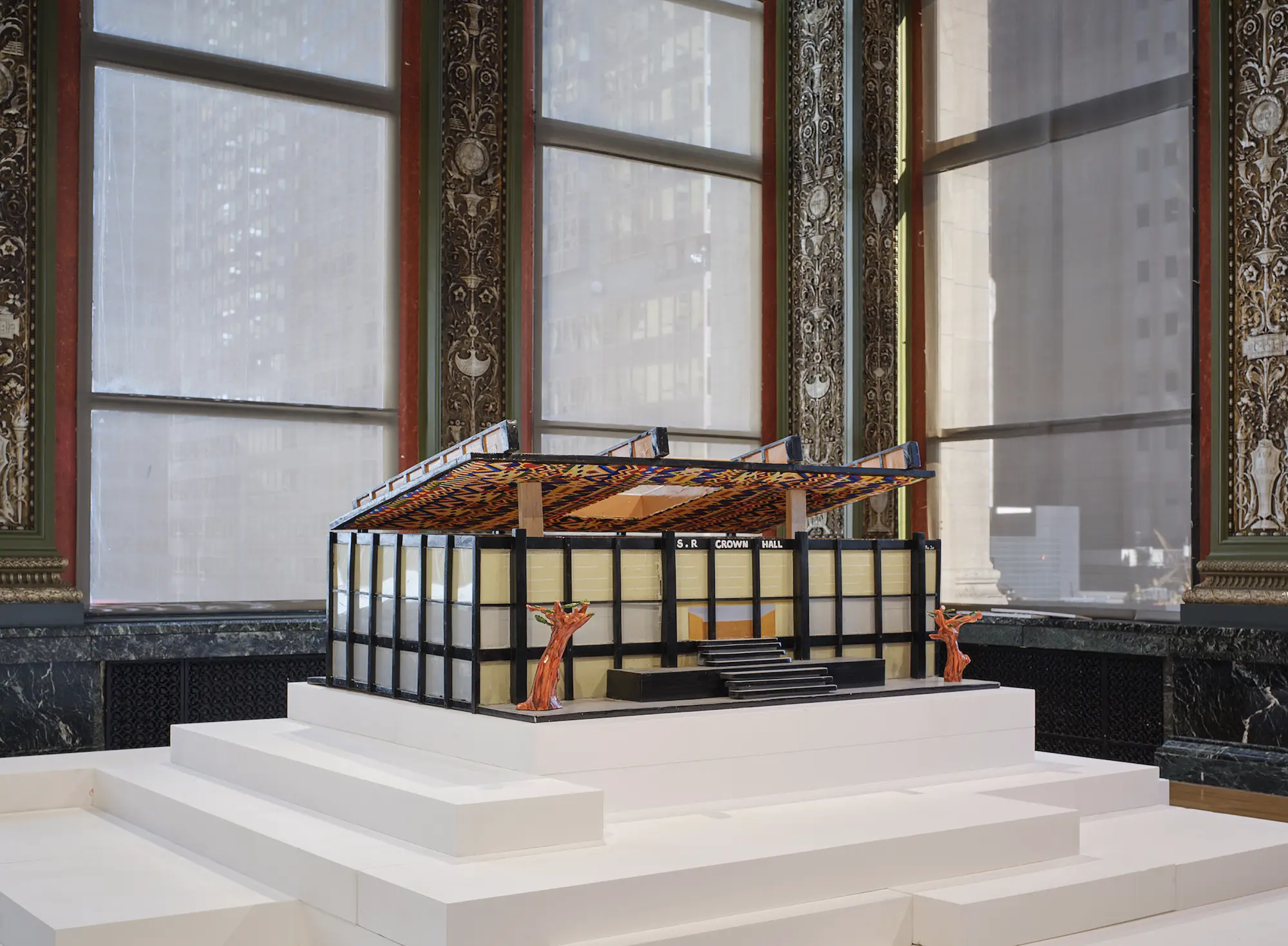
3
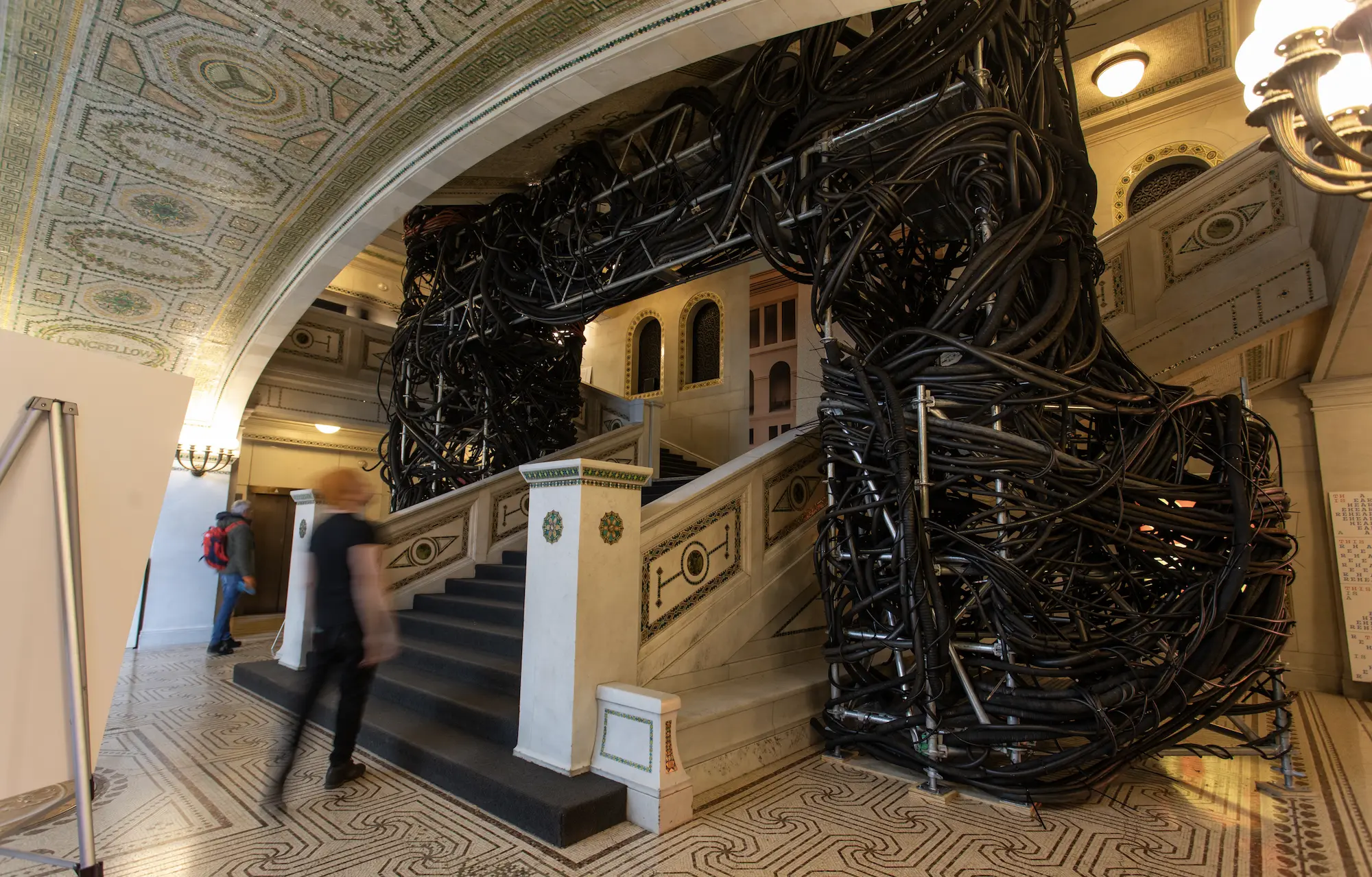
4
-6.39.02-PM.webp)
5
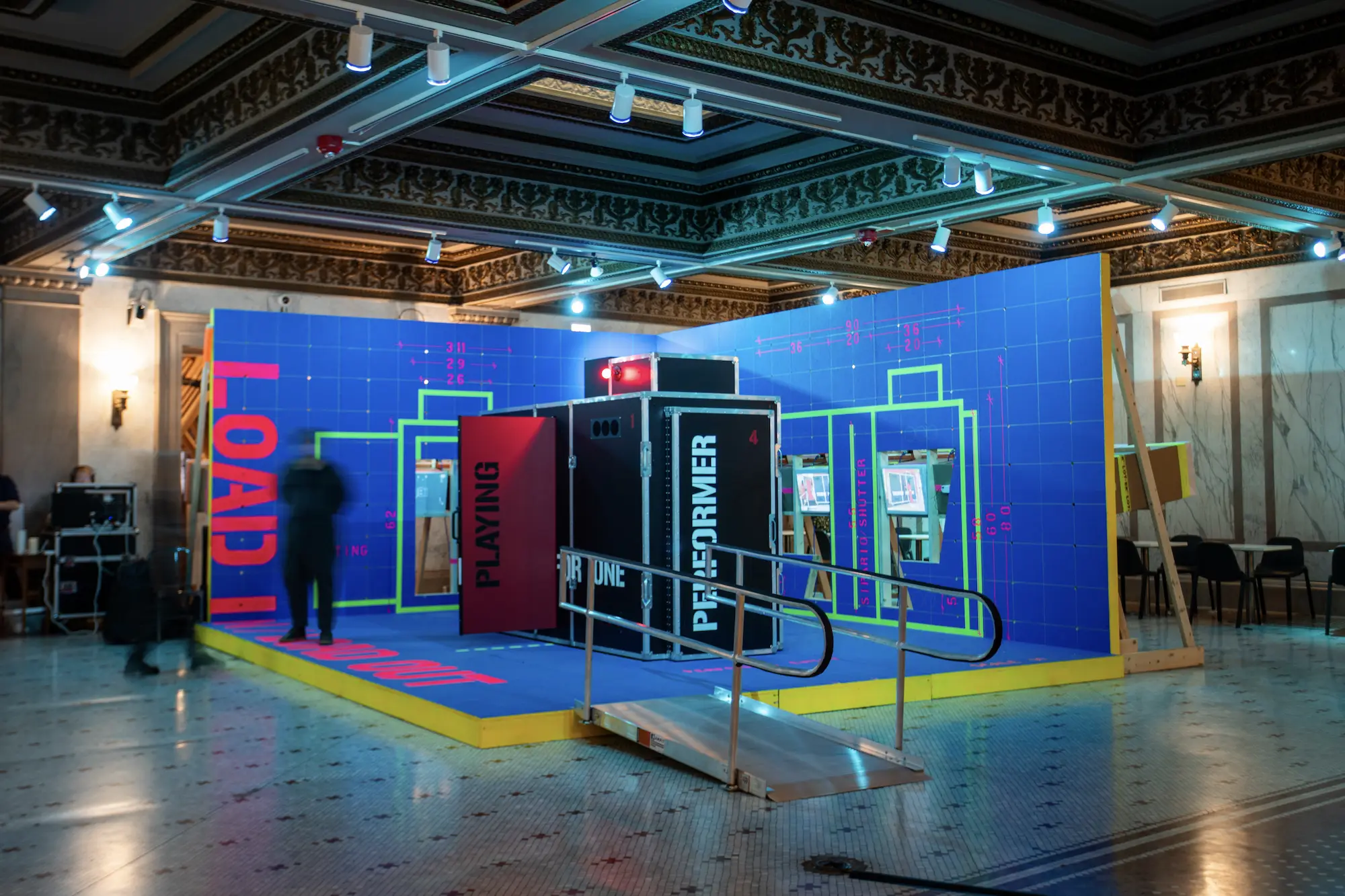
6.
Restoring old houses by Paa Joe (3); Pretty Wrecked by Asim Waqif (4); ukwé·tase by Chris T Cornelius (5); and LOAD IN LOAD OUT by LOT-EK (6), qll on view at the Chicago Cultural Center. Photos © Tom Harris (1–5), Cory Dewald (6)
On the very large city-stage that This is a Rehearsal occupies, the spotlight shines the brightest on the Chicago Cultural Center. But to experience CAB 5 as intended, visitors should also turn their attention to the supporting players spread across the city, including partner organizations like the Chicago Tool Library—and Urban Growers Collective to mention another—that will continue to make an impact in their respective communities and beyond long after the biennial closes. As for the Thompson Center, it’s best to visit soon—CAB 5 is this flamboyant landmark’s swan song before what will likely be a dramatic remounting.
-6.39.02-PM.webp)
Haywood House by Ruth De Jong at the Chicago Culture Center. Photo © Tom Harris
The Fifth Chicago Architecture Biennial: This is a Rehearsal
On view now through February 11, 2024, at the Chicago Cultural Center; closing dates for other participating sites vary.



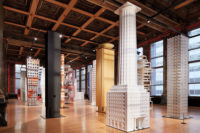
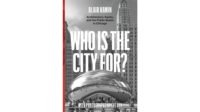
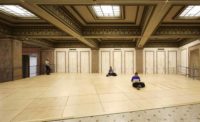
Post a comment to this article
Report Abusive Comment